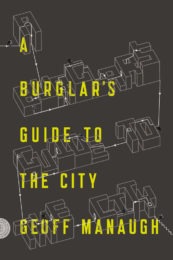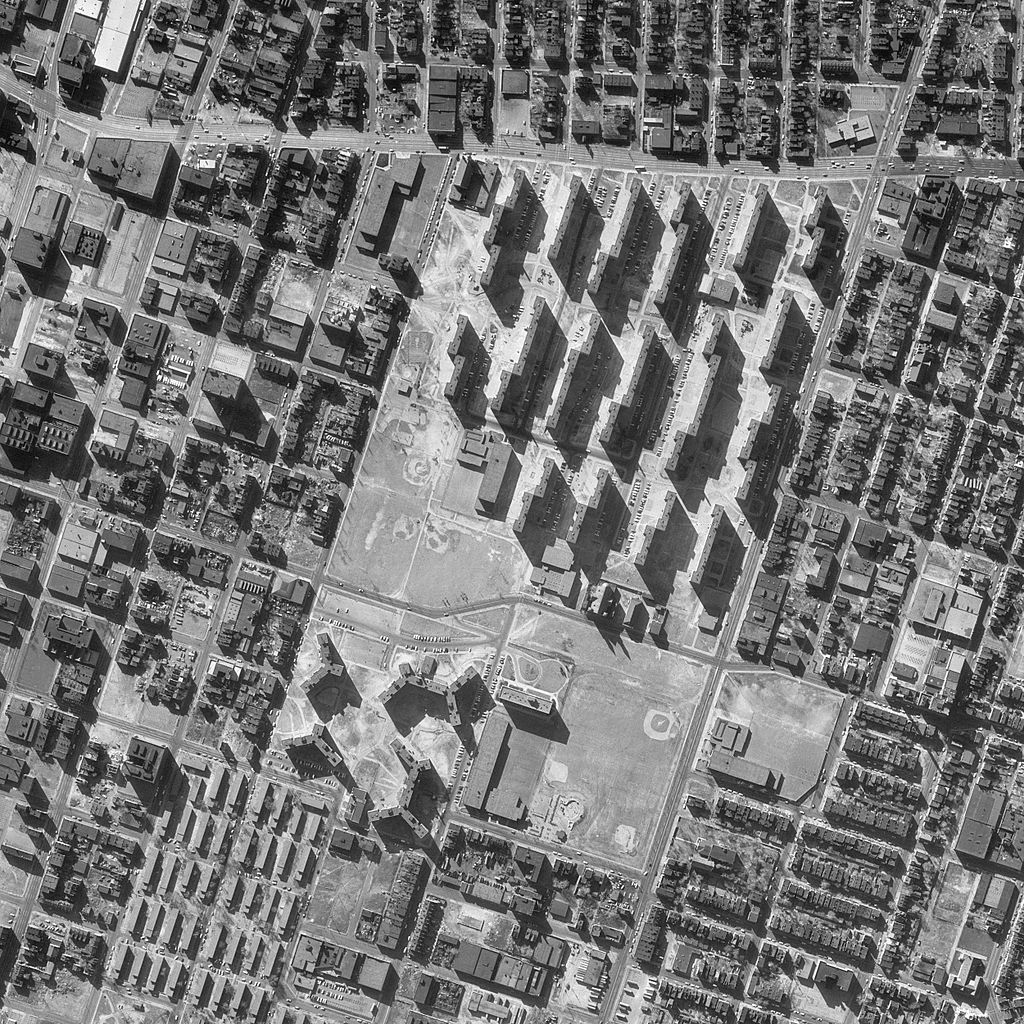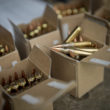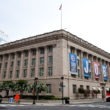Photo Credit: USGS
Architectural determinism has a strange effect: under its auspices, behavior is attributed to brick and mortar. Towers sow violence and destitution, either by creating irresistible opportunities for crime or structuring life in such a way that social contracts continually rupture.
The argument is at once both a perverse scapegoating and a peculiar form of architectural arrogance, one especially clear in the case of Pruitt-Igoe, a crime-ridden St. Louis public housing development demolished in 1972. According to determinists, the modernist architecture was so alienating that residents sought to destroy their home and allowed drugs and violence to overtake their community.
The social disintegration supposedly had little to do with the swift economic decline borne disproportionately by the working class; design was the prime suspect.

FSG Originals
304 pages, $16.00
Fortunately, the argument for architecture’s preeminent role in Pruitt-Igoe’s demise has been discredited, but gradients of determinism still exercise sway in thinking about cities. Geoff Manaugh’s The Burglar’s Guide to the City is the most recent installment in this canon, and bills itself as part of the curious genre of Architecture/True Crime.
Through extensive research, Manaugh documents how burglars and police alike approach and appreciate the physical world. Exceptional heist-film-worthy tales abound. One former burglar, Jack Dakswin, describes how he uses a deep understanding of city building codes to predict the basic layout of an apartment building simply by surveying its fire escapes, his mind’s eye traveling a treasure-laden path, from apartment to apartment and past alarmed exit doors, without ever having set foot inside.
But in appreciating the burglar’s nontraditional lens, Manaugh also unlinks the physical city from its social life. True to the tropes of architectural criticism and crime dramas, people largely disappear from Manaugh’s urban landscape, leaving only buildings, streets, and tunnels to be exploited. What results is the overstatement that “burglary is designed into the city as surely as your morning commute.”
The implications of this interpretation should trouble designers, policymakers, and residents. Manaugh characterizes crime as inevitable, even natural. More troubling, his argument justifies ignorance of the social roots of crime and reifies policing and incarceration as the predominant salves for social ills.
The flaws in Manaugh’s approach are particularly evident in the construction of a dichotomy worthy of Home Alone: “cops and robbers, good guys and bad guys, bandits and detectives, that eternal yin and yang of the world, its black and white, its good and evil.” This tidy, reductive fiction seems downright nostalgic amid popular unrest around police killings, militarization, mass incarceration, and the intensification of surveillance.
True to the tropes of architectural criticism and crime dramas, people largely disappear from Manaugh’s urban landscape, leaving only buildings, streets, and tunnels to be exploited.
With the facile, blanket characterization of burglars as “bad,” Manaugh then allows himself to indulge in reverence for a particular kind of mastermind. Under their creativity, water tunnels transform into get-away routes and the homogeneity of fast-food chains mutate into plans and timetables for an easy series of lifts. It’s the kind of romantic, intellectual thieving that makes you fall in love with the crew from Ocean’s Eleven. Despite Manaugh’s belated disclaimers about the psychological and material toll of being burgled, it’s hard not to be lulled by his descriptions of the perpetrator’s craft and their work’s particular insights for architecture.
These lessons largely amount to uncovering the hidden logics and layers of the physical environment and the ways architecture and cities can be “misused.” Unlike ordinary urbanites, “mere slaves to architecture,” Manaugh contends that “burglars use cities better.” Their lack of reverence for traditional means of entrance and egress unveil pathways through presumably solid structures.
Manaugh does a remarkable job cataloging the police techniques that proliferate to thwart these movements, but he often stops short of considering the implications of their use for anything beyond the law enforcement task at hand. When he crosses the pond to Rotherham, England, to learn about capture houses, Manaugh seems more caught by the idea of a building created to trap burglars than compelled to consider what it means for a place to be infused with this kind of police presence, real life supplanted with fake landscapes intended to encourage a crime.
As Manaugh does admit, most burglaries don’t fit the bill of his favored tales; people in need of money to get by or to satisfy a drug habit commit the vast majority of burglaries. These often-spontaneous acts might also have little to do with popular understanding of the crime, an outgrowth of its vague definition: unlawfully entering a structure to commit a felony. Manaugh admirably goes to great lengths to unpack its meaning and registers some concern with the definition’s bagginess, noting that “it is often easier to convict someone of burglary than it is of other crimes.” Are you homeless, squatting in a building, and in possession of some pot? You could be charged with burglary. The length of the sentence you might then face differs dramatically by jurisdiction, the type of structure entered (residential is more serious than commercial), degree of premeditation, presence of a weapon, use of force, and value of the loot. The federal U.S. Sentencing Guidelines suggests a minimum of 10 months in prison for the least serious burglaries, all the way up to 63 months (five and one-fourth years) for violent and particularly valuable crimes. (Some state statutes call for much lengthier sentences.)
But the crimes of desperation that land most burglars in jail lack the novel architectural insight of the premeditated bank robber and are thus unworthy of Manaugh’s further attention. As of 2014, 95 percent of U.S. inmates for whom burglary was their most serious offense were male; 42 percent were black. A survey of incarcerated burglars found that 48.6 percent of respondents used income from burglary on living expenses. These demographics, too, are erased by Manaugh’s architectural determinism, where crimes are understood as implicit in the city.
Manaugh’s inclination to look at places through the eyes of burglars and the police would prove extremely valuable were architecture jettisoned as his key variable. Deep observation of burglary—that is, looking at the crime as Manaugh’s brilliant criminal might look at a building—would reflect back more about our cities than the artfully layered axonometric he commits to in the book.
I am interested in a different burglar’s guide, one to the burglar’s own neighborhood, where the physical is treated as symptomatic—broken windows not a call to criminalization or an irresistible means of illicit entry but an indication of the kind of disinvestment, bias, and historical violence foundational to so much crime. This alternative guide need not foreswear architecture. Rather, it would see it within the context of its surroundings and its inhabitants. Environments are, after all, formative, not determinative, and as Manaugh does show, they contain far more information available for interpretation than is commonly accessed. All writing that truly unveils the city accesses these layers, not as elements to be deciphered into a particular formula but as complexity to be admired and explored.
Jonathan Tarleton is a writer, editor, and researcher based in Brooklyn.







“We shape our buildings and thereafter they shape us” was true when Winston Churchill said it, and it’s still true today. Tarleton can talk about “architectural determinism” and use exaggeration to create straw men that he can then blow down—but so what? Pruitt Igoe and all the other Towers in Parking Lots superblock housing projects were bad environments for their residents, and that continues today too. Just visit any NYCHA project and talk to the tenants. At the end, Tarleton perhaps admits as much at the end if his piece. but it’s hard to tell exactly what he means to say..